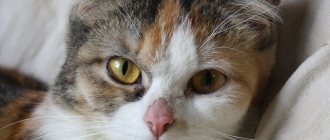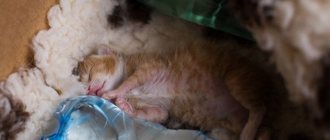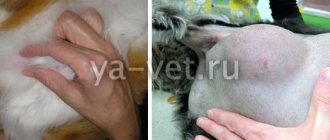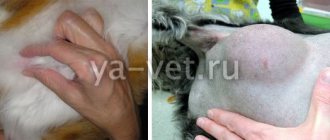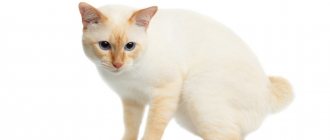An incomprehensible formation that appears near a pet’s nose or whiskers is a cause for concern for any owner. You should not ignore the fact that a lump appears. It can form due to many reasons. Some of them are very serious. Up to and including death.
Why a tumor may appear on a pet’s face:
- allergic reaction . Perhaps the cat has developed a high sensitivity to certain types of foods. Allergies are possible to toys, dishes from which the animal eats, as well as to medications;
- hematoma formation . It happens that with an injury or severe bruise, hemorrhage occurs in the soft tissues, so a hematoma is formed;
- acne. Even animals can get acne. Reason: indigestion, improper care of the cat;
- the muscle is inflamed . Due to hypothermia, the presence of parasites or infections in the body, a lump may form. If this condition is not addressed, tissue necrosis may occur;
- bite _ When an insect bites, a swelling appears. When a wasp, bee or bumblebee stings, toxic substances are released. They provoke severe swelling and compaction;
- abscess formation . If an infection gets into the animal's skin, suppuration may occur.
Pay attention to behavior . See what the bump looks like. Whether it feels soft or hard to the touch. Assess the condition of the skin around the tumor. If the skin is hot, inflammation occurs inside. Most likely, pus has accumulated inside the lump. If there is a lesion on the puffy cheek, there may be a risk of infection.
Oral diseases
If a cat has a formation on its face and the eye is festering, it may be due to a dental disease. Problems in the oral cavity can cause enlargement of surrounding tissues.
What diseases can lead to the formation of a swelling on the cheek?
- Flux . This is an infectious disease. Suppuration occurs in the periosteum and in the tooth. A lump with purulent contents forms. If the process is started, it can spread to neighboring tissues. Subsequently, a fistula forms and pus flows out of the resulting hole. If it lasts for a long time, the ears and eyes can fester.
- Gum disease . Oral infections can lead to various inflammations in the gums.
- Stomatitis . A painful ulcer appears in the mouth. Due to swelling and inflammation, the cat will not be able to open its mouth wide and eat.
Each of these diseases is painful. In order not to torment the animal, it is better to give it painkillers. It is necessary to contact a veterinarian as soon as possible. Prolonged illness will lead to tissue necrosis and jaw deformation. The cat will not be able to eat normally and will become very thin.
Why is my cat's lip swollen?
The fact that the lip is swollen means that something is causing inflammation in or around the lip. Many things can cause inflammation. Swelling is a common immune system reaction that the body produces in response to many insults. The swelling itself is usually caused by the release of white blood cells and fluids into the area, which rush to try and solve the problem. Let's look at some of the most common things that can cause swollen lips:
© shutterstock
- Injury
Cats are famous for their sophistication and elegance, but experience tells us that they often get into accidents, scratches, fights and blows. Sometimes they lack common sense! It is not uncommon for cats to be injured head first, and the injury can result in damage to the lips.
Both the injury and any subsequent infection can lead to swollen lips. Usually the lips are swollen in one place, and there may be other sores around the head, ears and neck. It's worth checking your cat's claws—scuffed and damaged claws are a good sign that your cat has been through something violent!
Symptoms
A swollen lip over a couple of days, which your cat may lick or clean excessively, often shows up as sores or swelling on other parts of the head. The lip will likely look angry and painful when touched. There may be discharge or pus from the swollen area, and cats may drip from one side of the mouth. Otherwise, your cat will be healthy and relaxed.
- Bites or reactions
This is usually more of a dog problem as dogs like to stick their head into things, but cats can also suffer from a reaction to something like a sting or nettle. For example, if a cat was chasing and trying to eat a bee or wasp, a bite to the mouth may cause the lips to swell. These are allergic reactions, but they are usually mild. More serious allergic reactions (known as hives or anaphylaxis) are rare but possible. Again, the lips will likely be swollen in only one place, although swelling may be everywhere.
Symptoms
Sudden appearance (within a few hours) of a swollen lip - Your cat may hold her mouth open and pant heavily or harshly. There may be tumors or bumps on the rest of the body. Sometimes the whole head swells! Your cat will be hypersensitive and agitated, often dripping heavily from the mouth. There will usually be no discharge from the swollen area, but you may see a small brown bee or wasp sting - try brushing it off with a light touch of your finger if you can do so safely.
- Oral or dental disease
Cats are prone to oral and dental diseases. They are known as gingivitis or stomatitis, depending on which parts they affect and how severe they are. Like all animals, cats suffer from tooth decay, tartar, and plaque, but in cats they can become much more complex and sinister than in other species due to the interaction between several factors in the mouth—bacteria, viruses (especially calicivirus), and the immune system itself.
While plaque and tartar progress slowly in most animals, cats can have massive, inappropriate reactions to the bacteria and viruses that live in the mouth, causing enormous inflammation even when the teeth appear fairly clean and healthy. This can even cause the teeth to begin to sink back into the jawbone! As you can imagine, this disease is really painful and unpleasant, just like mouth pain for us.
Symptoms
Slowly progressive swollen lips (several days to weeks or more) in several places, especially at the corners of the lips. The swelling will gradually increase along with other symptoms. Your cat may be slow or reluctant to eat, especially avoiding crunchy hard objects. You may have noticed that he has bad breath.
If you see your cat's teeth, you will notice severe redness in the gums around some or all of the teeth, and red spots may appear on the tongue and roof of the mouth. Your cat may clean and lick, and a small amount of fluid may come out of the mouth. You may notice blood in the water bowl after your cat has had a drink.
© shutterstock
- Autoimmune diseases
Autoimmune diseases are generally rare in all species. In humans, rheumatoid arthritis is a good example of how troublesome these problems can be. Essentially, the immune system incorrectly attacks or damages some part of its own body.
Cats suffer from a special group of diseases called eosinophilic granuloma complex, known as EGC or as indolent ulcers or rodent ulcers. They are not well understood and can vary, but essentially there is an influx of white blood cells called eosinophils into a specific area of the skin. The attack often occurs in the mouth, lips or throat, but can occur anywhere on the cat's body. This surge of cells causes pain, swelling, severe inflammation, discharge and, surprisingly, can also become infected! They come in three main types, but can be very different from cats.
EGC often has no clear cause, but has been associated with various factors that can trigger the immune system, including food intolerances, allergies to parasites such as flea or mosquito bites, or something in the environment (such as pollen) and viruses ( especially feline immunodeficiency virus (FIV).
Symptoms
Swelling on the skin or mouth appears fairly quickly (within a few days) and can be very itchy and painful. The ulcers affect the upper lip and palate - they are raised, red, angry and fairly well defined at the edges. Other types of EGC appear as raised, irritated patches of skin that are yellow/pink in color, painful, and weeping with discharge. Cats are otherwise generally well, but feel discomfort and may have difficulty eating. They may groom themselves excessively and dribble the ball.
- All the rest
This list is by no means exhaustive, and there are many reasons why cats may develop a swollen lip. Regardless of the reason, if you are concerned about your cat, you should seek professional, qualified care from a veterinarian as soon as possible. Only a veterinarian can properly diagnose and treat these problems to ensure the correct solution is provided to your cat as soon as possible.
© shutterstock
Oncological formations
Oral cancer is a rare occurrence. According to statistics, in three cats out of a hundred, cancer causes the formation of a malignant lump in the area where the whiskers grow. Therefore, if you notice a tumor on the face, immediately contact a veterinary clinic.
The cause of a malignant tumor can be a pet’s poor diet, based only on canned food. Smoking by the owner in the presence of the animal. Most often, squamous cell carcinoma or fibrosarcoma . Cancer treatment is carried out outside the home. The sooner the owner contacts the clinic for a diagnosis, the greater the animal’s chances of survival. As a rule, surgical removal of a tumor on the cheek is prescribed. To prevent metastases from appearing, doctors administer chemotherapy. But if the owner missed time, did not pay attention to the symptoms and started the disease, it will not be possible to cure the cancerous tumor.
How to diagnose the cause
Treatment will depend on why the swelling occurs. Sometimes the source of the problem can be recognized immediately - for example, if a swollen lip occurs after a wasp or a bee has landed on it, then, without a doubt, the problem is an insect bite. But more often than not, the cause cannot be determined. To find out the diagnosis, you will have to carry out a number of manipulations. First of all, you need to observe the cat to identify other symptoms:
- Dental diseases, in addition to swelling of the lips, are accompanied by: an unpleasant odor from the cat’s mouth;
- redness of the gums;
- increased salivation.
- sudden weight loss;
Visual observation of the animal alone is not enough to establish the exact cause of lip swelling. Veterinarians also use a comprehensive diagnostic method, including:
- general blood analysis;
- tissue biopsy (to exclude tumor neoplasms);
- allergy test;
- microscopy (to detect bacterial infection, skin parasites, mycosis).
If dislocations or jaw fractures are suspected, radiography is performed.
How is the treatment carried out?
Depending on what caused the lump, the veterinarian will prescribe the necessary treatment. It is carried out in a veterinary clinic.
Treatment of formation on the cheek:
- drug therapy. Antibiotics, antiseptic drugs, antiallergic and anti-inflammatory drugs are prescribed;
- applying a cold compress;
- chemotherapy and radiation therapy;
- pus is removed. A drainage tube is installed to drain it.
If the owner did not immediately pay attention to the lump and the tumor on the face bursts, you need to contact a veterinarian as soon as possible. Painful sensations will prevent the cat from eating and drinking. An open wound can become infected and become infected.
Allergic reactions
If your cat's lower lip is swollen and there are no signs of a bite, then it is likely that the cause of the problem is an allergic reaction. In most cases, the swelling process begins a few minutes after contact with the allergen. In severe forms of allergies, the entire face usually swells. But if only one lip is affected, then the problem can be dealt with by using antihistamines.
However, you shouldn’t put off going to the vet: a specialist will help you identify the allergen and also select the best medicine in case a negative reaction occurs again. The doctor will also be able to confirm or rule out eosinophilic granuloma (an inflammatory disease with symptoms similar to common allergies). The exact causes of the pathology are not known, but eosinophilic granuloma is believed to be the result of cat hypersensitivity.
Diagnostic procedures
Sometimes the owner can independently determine the cause of the swelling. This is possible if you know of a recent injury, bite or allergy to any irritant. Knowing the cause will help your veterinarian prescribe treatment. In other situations, only a doctor is involved in diagnosis. After talking with the owner, he will conduct an external examination, which is sometimes enough to determine the cause of the swelling.
If necessary, the veterinarian takes a swab from the oral cavity, the contents of the discharge, and blood for laboratory tests. This will help identify the type of pathogen, if any. If a tumor is detected, additional diagnostics are carried out to determine its benignity. A biopsy, ultrasound, x-ray, MRI or CT scan is performed. This will help you find out the type of tumor and stage of the disease.

